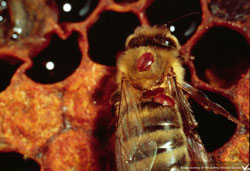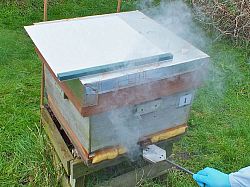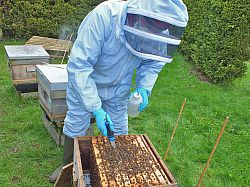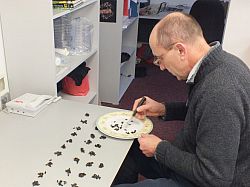Varroa mites, Varroa destructor, evolved in Asia where they are a parasite of the Asian honey bee Apis cerana. They have since become a pest of the Western hive bee Apis mellifera and have spread worldwide. Large numbers of Varroa mites can kill a bee colony and the mites can also increase virus mortality.
 Varroa mites on an adult honey bee
Varroa mites on an adult honey bee
 A honey bee colony being treated with Oxalic Acid using sublimation method
A honey bee colony being treated with Oxalic Acid using sublimation method
 Oxalic Acid varroa treatment using the dribbling technique
Oxalic Acid varroa treatment using the dribbling technique
 Research facilities manager, Luciano Scandian, counting bees
Research facilities manager, Luciano Scandian, counting bees
Controlling Varroa is considered essential for successful beekeeping. Varroa was first detected in Britain in 1992. Until recently, Varroa could be controlled using Apistan strips. Apistan contains a chemical (fluvalinate) that is toxic to the mites but is safe for honey bees and humans. Treating a hive with Apistan needed a few minutes work per year and cost just a few pounds.
However, fluvalinate-resistant Varroa now occur throughout much of the world including much of Britain. Alternative methods to kill Varroa have been developed and tested in Europe and North America, especially in countries that never permitted the use of Apistan or where the mites have been resistant for longer. These variously use fumigants (formic acid, thymol), spray the bees in a hive with a solution harmful to Varroa (lactic acid, oxalic acid), trap mites in drone brood that is then removed from the hive and killed, or make use of a mesh hive floor which allows the varroa to fall through and die.
An important strand of our research on pests and diseases concerns the application of oxalic acid (OA). Although OA has been used by beekeepers for several decades to kill varroa, it became clear that a study was needed to determine the effectiveness of different doses and application methods on mite and bee mortality.
An experiement conducted by researchers at LASI using 110 hives comparing three application methods and three different doses was completed in 2014. Hives were treated in early January 2013 when they had no brood. Oxalic acid does not kill varroa in sealed cells, but rather kills those varroa transported on the bodies of workers and also those crawling in cells not yet capped.The researchers determined the proportion of mites killed by washing the mites off a sample of approximately 300 workers bees immediately before and after 10 days of treatment with OA. They also determined the number of bees killed at the time of treatment, together with hive mortality and strength 4 months later in spring.
The results came to a clear and encouraging conclusion. Application of OA via sublimation, where OA is applied in its pure form by vapourising the crystals with a special heated tool, was superior to application as a solution via either spraying or dribbling. Sublimation gave a greater kill of varroa at a lower OA level and showed no increase in bee mortality. In fact, 4 months after treatment, the hives treated via the sublimation had more brood than the 10 untreated colonies.
The sublimation method is quick and easy, as the hives do not need to be opened. To confirm the results obtained by LASI researchers early in 2013, the sublimation technique was retested one year later in December 2013, just before Christmas, in broodless honey bee colonies. An amazing 97% of the varroa were killed by using 2.25g of oxalic acid per hive, and colony survival 3 months later in spring was close to 100%.
This research project was overseen by Prof. Francis Ratnieks and led by PhD student Hasan Altoufailia. LASI facilities manager, Luciano Scandian, assisted with his extensive beekeeping knowledge. The results will be published shortly.
References
Awaiting submission:
Al Toufailia, H. M., Scandian, L., Ratnieks, F. L. W. The effectiveness of spring drone brood trapping to control Varroa populations in honey bee colonies.
Al Toufailia, H. M., Scandian, L., Ratnieks, F. L. W. Effectiveness of different methods of quantifying Varroa populations in honey bee colonies.
Published:
Al Toufailia, H. M., Amiri, E., Scandian, L., Kryger, P., Ratnieks, F. L. W. (2014). Towards integrated control of varroa: effect of variation in hygienic behaviour among honey bee colonies on mite population increase and deformed wing virus incidence. Journal of Apicultural Research 53, 555-562.
Al Toufailia, H.M., Scandian, L, Ratnieks, F. L .W. (2015) Towards integrated control of varroa: comparing application methods and doses of oxalic acid on the mortality of phoretic Varroa destructor mites and their honey bee hosts. Journal of Apicultural Research, 54(2), 109-121
Popular Journals:
In British Beekeeper's Association's British Bee Journal
Varroa BBJ 1-15 [PDF 623.42KB]
In BeeCraft February 2016
How Effective is Apistan® at Killing Varroa?
In Bee Farmer October 2016
Comparing the Effectiveness of Different Control Methods Against Varroa
Pamphlet:
How to Determine Varroa Infestation Levels
How to Apply Oxalic Acid Via Sublimation to Control Varroa
Pamphet in Other Languages:
Dutch/Nederlands:
Applying Oxalic Acid via Sublimation to Control Varroa (Dutch)
French/Français:
Applying Oxalic Acid via Sublimation to Control Varroa (French)
Finnish/Suomalainen:
Applying Oxalic Acid via Sublimation to Control Varroa (Finnish)


